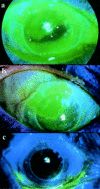The conjunctiva in corneal epithelial wound healing
- PMID: 9930272
- PMCID: PMC1722446
- DOI: 10.1136/bjo.82.12.1407
The conjunctiva in corneal epithelial wound healing
Abstract
Background/aims: During the healing of corneal epithelial wounds with limbal involvement, conjunctival epithelium often migrates across the denuded limbus to cover the corneal surface. It is believed that, over a period of time, conjunctival epithelium covering the cornea assumes characteristics of corneal epithelium by a process referred to as conjunctival transdifferentiation. The purpose of this study was to examine, clinically, the fate of conjunctival epithelial cells covering the cornea and to assess the healing of corneal epithelial wounds when the conjunctival epithelium was removed or actively prevented from crossing the limbus and extending onto the cornea.
Methods: 10 patients with conjunctivalisation of the cornea were followed for an average of 7.5 months. Five patients in this group had their conjunctival epithelium removed from the corneal surface and allowed to heal from the remaining intact corneal epithelium. In another four patients with corneal epithelial defects, the conjunctival epithelium was actively prevented from crossing the limbus by mechanically scraping it off.
Results: The area of cornea covered by conjunctival epithelium appeared thin, irregular, attracted new vessels and was prone to recurrent erosions. Conjunctivalisation of the visual axis affected vision. Removal of conjunctival epithelium from the cornea allowed cells of corneal epithelial phenotype to cover the denuded area with alleviation of symptoms and improvement of vision. It was also established that migration of conjunctival epithelium onto corneal surface could be anticipated by close monitoring of the healing of corneal epithelial wounds, and prevented by scraping off conjunctival epithelium before it reached the limbus.
Conclusion: This study shows that there is little clinical evidence to support the concept that conjunctival transdifferentiation per se, occurs in humans. "Replacement" of conjunctival epithelium by corneal epithelial cells may be an important mechanism by which conjunctival "transdifferentiation" may occur. In patients with partial stem cell deficiency this approach can be a useful and effective alternative to partial limbal transplantation, as is currently practised.
Figures







References
Publication types
MeSH terms
LinkOut - more resources
Full Text Sources
Other Literature Sources
